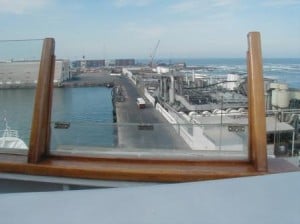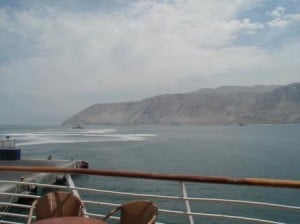The lay out of the dock of the port of Iquique was almost identical to that of our last port Arica. Again an L shaped breakwater with a smaller pier inside but just a little bit bigger. The bad news was that there was a fishmeal processing plant on the pier where we docked. The good news was it was not in operation as they were carrying out maintenance. So although there was a distinctive smell hanging over the port it was not unbearable. Yesterday on arrival we had Sea Lions honking (that might be the wrong expression for a sea lion call but that is what it sounded like) at us on arrival and this morning we had seals frolicking around the ship when we came in. We had them again on departure and then they found the cooling water exhaust of the main engines. The out flowing water must have been enjoyable as they kept playing in it. I am all for wild life around the ship but it did make the maneuvers more difficult as you do not want to get one of these graceful animals caught in the bow thrusters. So we floated in and out of the port a little slower then I am normally used to.
As we are coming closer and closer to the bad weather areas of South America we are starting to notice the long running swell that comes all the way from the Cape Horn Latitude. At the moment it is still a gentle movement but I expect that in the coming days it will become more pronounced. That makes our arriving and departing from these ports a little bit more complicated as I want to prevent the rolling of the ship as much as possible when going into the ports. The last few ports that we have visited all have instigated Vessel Traffic Separation Schemes for the traffic around their ports. No doubt to improve the safety of the navigation at sea but the approach courses are perpendicular to the general direction of the swell and that means that the ship rolls when slowing down to pick up the pilot. Maybe not a problem for the cargo ships going in or out but I have a bit more precious and “loose” cargo on board. Thus far I have been able to deal with it as the swell was not that high yet and the draft of the pilot boats very small. That means that I can keep the stabilizers out while we are moving slowly for the pilot exchange without the danger of the pilot boat hitting the stabilizer. In a port as Manta where the pilot comes onboard via a large tugboat that was not possible so the ship rolled more than I liked.
Although the stabilizers need speed to be fully functional they can help at very low speed as their drag through the water still creates a dampening effect on the rolling movement of the ship. So I keep them out until the ship enters the dock area and before coming alongside. The Officer of the watch is standing at the stabilizer panel on the bridge and the moment we are out of the swell the stabilizers are retracted.
 View from the bridge. Today I could study the dseign of a fish factory from very nearby. It looks very much like an petro – chemical plant.
View from the bridge. Today I could study the dseign of a fish factory from very nearby. It looks very much like an petro – chemical plant.
The town of Iquique was well liked by the guests, clean safe and friendly. However as with Arica, the surrounding area is very desert like and stark in appearance.
 View from the stern across the entrance bay.
View from the stern across the entrance bay.
Here a view from the stern with the bare cliffs towering above the bay in the distance. The foam that you see on the waves is a local phenomenon in the sea water. When the swell is running on the flood large layers of foam are appearing on the water surface. The pilot did not speak enough English to explain this strange occurrence but he said it was very natural and happed all the time. It had nothing to do with the fish processing or pollution.
For the weather in the coming days we are looking good for Coquimbo and Valparaiso but our crossing to Robinson Crusoe island might be more interesting. There is a small frontal system pushing itself up towards this remote island and might result in a very interesting situation. However that is still four days away and the weather is very changeable here.

February 3, 2010 at 2:39 am
Captain,
The sea foam is a phenomena relative to the southern oceans and common in rocky fjord laden areas as Chile and New Zealand.
The foam is a mixing of a bottom dwelling algae (macroalgal propagules) and common sea layer plankton.
What makes the sea foam such a phenomena is due to the conditions you describe with the rhythmic sea swells from further south. The algae does not disperse from the rocky bottom in normal wave action or breakers. Instead the rhythmic or orbital swell motion activates the algae and while mixing with plankton, and then becomes abundant sea foam.
Deep southern ocean storms will create walls of seam foam in the entrances to harbors, eddies of fjords and tidal current intersections.
Perhaps you will sail Prinsendam into a southern ocean ‘Bubble Bath’,
February 3, 2010 at 9:29 am
Perhaps the seals there ‘honk’ . The ones I hear BARK, like a dog only not quite…I am enjoying your voyage, the photos and narrative here. Grand stuff this is!
February 3, 2010 at 1:47 pm
Some call sea lion’s noise barking but I thinking honking is the right sound. When we were on an excursion in Hawaii, we were surrounded by whales and this was called “mugging”. So I guess you were “mugged” by sea lions. Wish I was there! Good sailing further south.